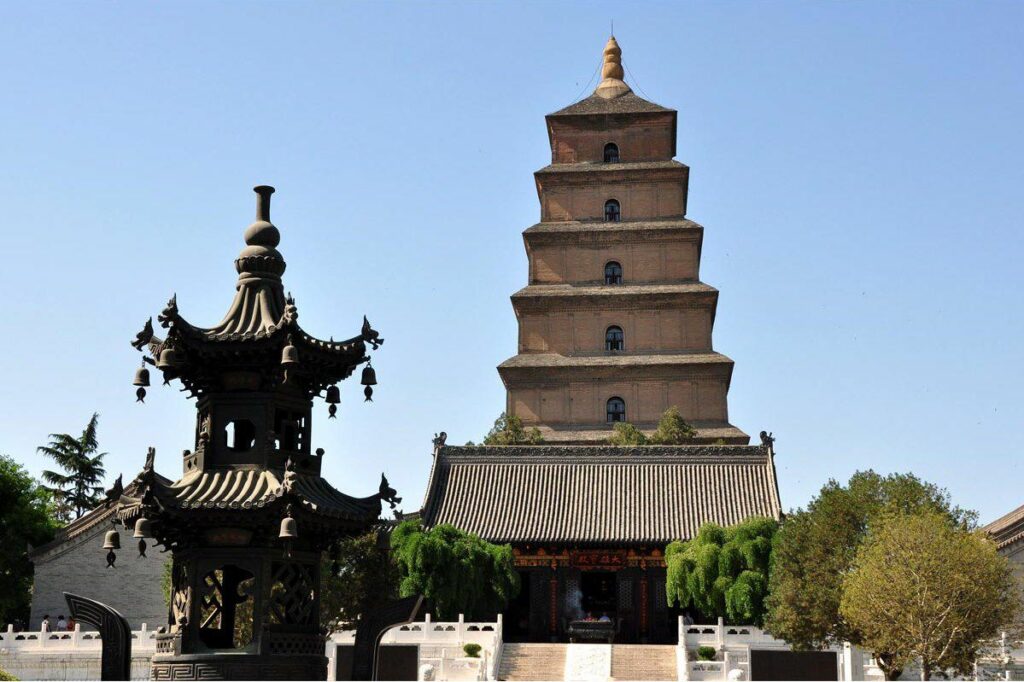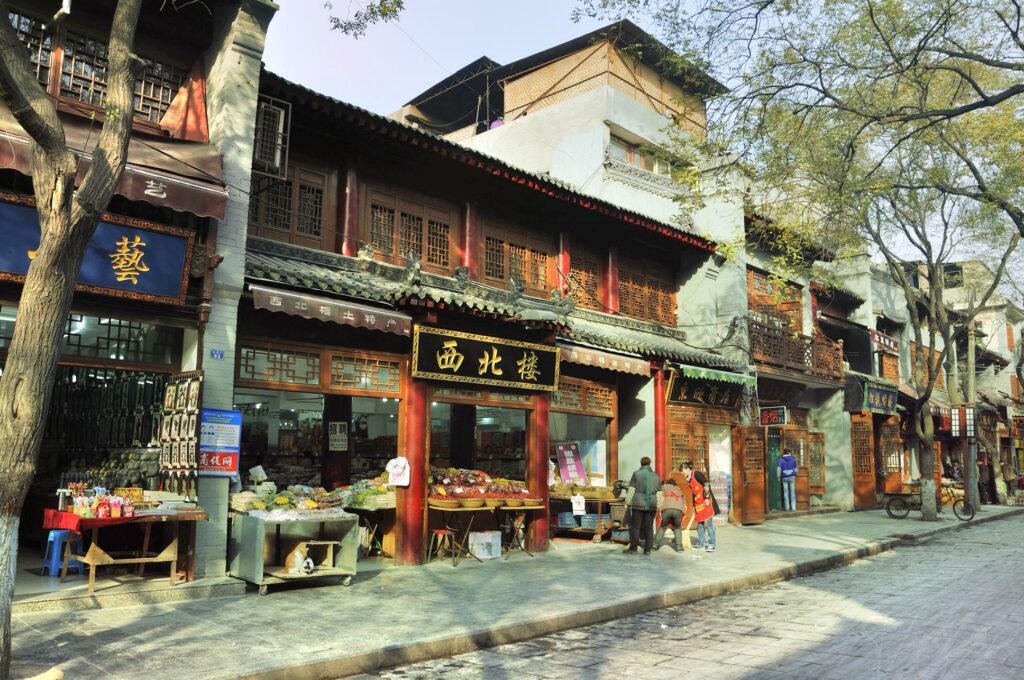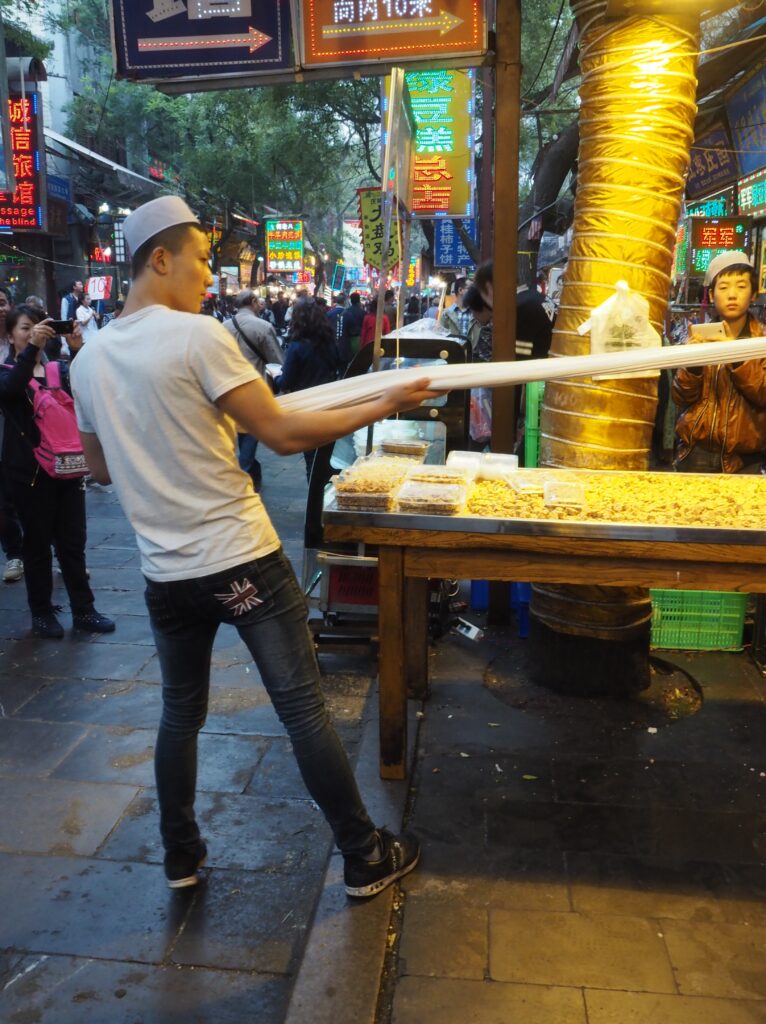Return to Xi’an, one of the three Chinese cities to have preserved almost all of its “imperial” walls, too. Parks have been set up around which invite you to relax. Before leaving for other intramural discoveries this time.
Historic capital of the Middle Kingdom for more than a thousand years, Xian also conveys the completely mythical image of the Silk Road, of which it was the starting point. Merchant exchanges between East and West are here within the reach of a waking dream. In the warm atmosphere of the Muslim quarters, rich in colors and perfumes, one imagines these rough caravanneers covering their precious loads of silk or unloading these mysterious goods from a distant West.
Beiyuanmen
Entirely rebuilt in the old fashioned way, Beiyuanmen Street and its souvenir shops bring you back to a much more prosaic reality: you haggle, you buy and, in the evening, you feast on a skewer of lamb in the smoky atmosphere of a brazier.
The Great Mosque
Known for its spiritual radiance, it illustrates the golden age of the Tang where tolerance presided over the mixture of cultures. Built in the year 742, on a Chinese-inspired plan and architecture, it is, after that of Canton, the largest mosque in China The 17th century entrance door with magnificent sculpted beams opens onto a succession of courtyards, gardens and pavilions. The imposing prayer hall topped with blue-green glazed tiles can accommodate a thousand worshipers and, thanks to openings, you can see superb sculpted panels evoking the Koran.
The imperial walls
Xi’an is proud to have preserved almost all of its ramparts. Built in rammed earth under the Ming in the 14th century, bricks reinforced their structure in 1568. 4 watchtowers. Impressive. It is on foot, by bike or in an electric cart that you stroll on this boulevard of the past. From the south gate, the gaze embraces a superb landscape embellished every day, at set times, by the martial parade of soldiers marching in Tang uniform.
Nature has taken its place at the feet of this gigantic work: many gardens and themed areas have been laid out where it is good to laze around, do Tai Chi, play chess, table tennis, mah-jong… or just playing kite.
Wild goose pagodas
There is the small one (1km from the city) and the big one (4km). But no need to look for any representation of this chubby bird, you won’t find one! Among the legends explaining this name, there is that of a monk lost in the desert… a goose came down from the sky and guided the thirsty to the nearest oasis. Lovely!
These pagodas were founded in the 7th century in the enclosure of two large and very active temples. Nothing remains except the memory of two pilgrim-adventurer monks. Risking their lives most of the time, they brought back thousands of sacred texts from. of all the high places of Buddhism in Asia
The Great Wild Goose Pagoda. It welcomed the documents collected by Xuanzang (602-664) during his wanderings and he worked on their translation until the end of his life. Before dying, he would have confided to having had a premonitory vision: celestial creatures welcoming him with flowers and various offerings. But goose, period. Curious. A small museum retraces his life via books and some frescoes; a thousand Buddhas adorn the ceiling of his study room.
Be careful, 64 meters of stairs as steep as they are narrow have to be climbed to reach the top of the large pagoda and enjoy a breathtaking view of the beauty and the animation of the site. And see in the distance the silhouette of…
The Little Wild Goose Pagoda
It has only 13 floors since lightning pulverized two of them on a stormy day. It was in the temple near which it was erected that Lijing (635-713), our other adventurous monk, returned to his household. He participated in the development of the translation center for Buddhist writings, one of the most renowned in the world. There is no trace here of his immense quest for knowledge or of his work. Some of his rolls of translations were found in a cave in Dunhuang (site that we will discuss soon).
Discovered by a French archaeologist, they appear, digitized, in the catalog of the National Library of France. To the many steps to climb to reach the summit with a view, from the small pagoda of the wild geese one can prefer the tranquility of the surrounding gardens and their small rebuilt temples, dedicated to local crafts or calligraphy workshops.
Xingqing Park
Extending over some 50 hectares, it is the largest park in the city and it bears the name of the emperor (712-756) who led the Tang dynasty to its peak. The site was laid out on the same site where he lived, his palace, his lands and the lake on which, according to the chronicles, he loved to go boating with his five concubines. A 10 ha lake therefore covers the center of what is like a hymn to nature in any industrial and dusty city. Chenxian pavilion and its flower bed, temples, pavilions, pagodas, large aviary…everything is there to charm the walker. Even some of the most diverse animations. Animal trainers, for example. The Chinese love it.




